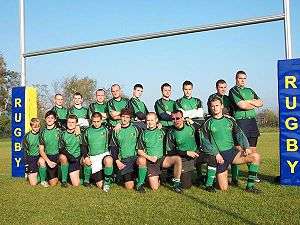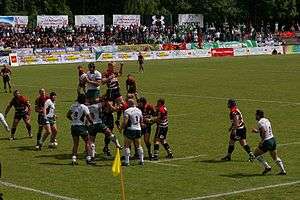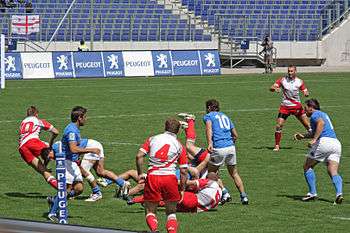Rugby union in Poland
| Rugby union in Poland | |
|---|---|
|
Budowlani Łódź playing Lechia Gdańsk | |
| Country | Poland |
| Governing body | Polski Związek Rugby |
| National team | Poland |
| First played | 1922 |
| Registered players | 6,779 [1] |
| Clubs | 74 |
National competitions | |
Club competitions | |
Rugby union in Poland is a minor but growing sport.
Governing body
The Polish Rugby Union (Polski Związek Rugby) was founded in 1957, and joined the IRFB in 1988.[2] The official supplier of equipment to the PRU is O'Brien sport.
An earlier Polish Rugby Union was set up in the early 1920s, but was disbanded in 1928.[3]
History
In 1921, Louis Amblard, a Frenchman, set up the very first Polish rugby club called "The White Eagles".[3] The first match was in 1922,[3] and the first club international in 1924 against a Romanian side.[3]
The game became established in the Warsaw Military Academy in the early 1930s.[2]
The tragic events of World War II, the Molotov-Ribbentrop Pact etc., meant that the growth of Polish rugby was retarded until the 1950s.[2] During World War II, there were occasional games between allied POWs in German camps in Poland.[4] For example, a game was held between a Scottish and a Welsh XV, in ten inches of snow.[4] No conversions were allowed, as the ball would have gone over the camp fence, and the game was twenty minutes each way.[4] Players wore army boots, trousers, prison shirts and balaclavas.[4]
Polish rugby arguably achieved its greatest success in the late 1970s when the national team beat Italy, Spain and the USSR, and also held Romania to a 37-21 win in 1977.[2]
- "Much to everyone's surprise, Eastern Bloc countries are among the game's vigorous participants, seemingly oblivious to rugby's capitalist class-ridden origins. Russia emerged from behind the Iron Curtain and came under international scrutiny when they played France in Toulouse in November 1978. Rumania, Poland and Czechoslovakia are members of the Federation Internationale de Rugby Amateur, the governing body for those countries not in the IB."[5]
In 1983, Poland failed to play Italy in the FIRA Championships, and told FIRA that two of their players had died.[6] It is not known where the other died, but one had died near Bucharest.[6]
The Cold War frequently intruded - for example in the 1984 FIRA Championships, in the game against France, Poland demanded the removal of the French players Didier Camberabero, Henri Sanz and the Brive RFC centre Yves Fouget, because as members of the French armed forces, they were considered to be a security risk.[6]
Because of high Polish emigration, particularly to France, and English speaking nations, the Polish team actually has a fairly large pool of potential players. In addition, a number of Poles returning from jobs in the British Isles and France, have carried the game back with them.
Notable players
In the 1990s, there were at least fifty Poles playing in the French first and second divisions.[2] Notable amongst these was Grzegorz Kacala, the 114-kilogram (18.0 st) open side flanker, who helped Brive win the 1996 European Cup.[2]
Mariusz Pudzianowski, better known as a Polish strongman, is one of the most famous Polish rugby players. He played with Budowlani Lodz but retired after one season.[7][8]
Skill standard
The standard of domestic rugby is relatively low in Poland. Most national players play in lower division teams in France (even in second/third teams) while some national players play in the domestic league. The main teams are based in the three main conurbations of Tricity, in Warsaw and Łódź (the latter, being current national champions). In Poland, because rugby union is viewed as a "power sport", flamboyance is not encouraged. The lack of foreign coaches stifles development, which is reflected by the national team's performances in the European Nations Cup against nations with less financial muscle and a smaller player pool such as the Czech Republic and the Ukraine, as well as matches against Kazakhstan, and Morocco.
Domestic structure

There are currently three divisions in Poland. The second division was relaunched in 2009 using some of the major teams providing 2nd XVs, along with some newly formed sides. The top division has 8 teams while the second division has 6 teams.[9] Prior to that in 2008/2009 there were 10 teams in the top division and only 4 in the second.[10] This led to some very uneven contests between the top teams and those at the bottom of the league. There is now also a regional league played in the centre of Poland (around Lodz and Warsaw) in which some smaller clubs have entered teams and second teams from some of the top clubs nationally compete.
Polish rugby development, however, has tended to concentrate on rugby sevens as a means of introducing the sport to people.[11] The PRU organises regular one day sevens tournaments over the spring/summer with teams travelling from all over the country. There are teams forming all over the country, but there is a shortage of quality coaching and basic equipment. Despite this rugby is making good headway.
Rugby tens also has some popularity.[12]
National team
Poland's international debut was in 1958 against East Germany, and they won the match 9-8.[3]
Women's rugby
Although Poland's women have not yet played test match rugby, they have been playing international sevens rugby since 2005. (Current playing record).
See also
| Wikimedia Commons has media related to Rugby union in Poland. |
External links
- IRB Poland page
- Official union page
- Poland rugby news
- (French) Archives du Rugby: Pologne
- Poland Tapping into French Rugby Roots
References
- Cotton, Fran (Ed.) (1984) The Book of Rugby Disasters & Bizarre Records. Compiled by Chris Rhys. London. Century Publishing. ISBN 0-7126-0911-3
- Richards, Huw A Game for Hooligans: The History of Rugby Union (Mainstream Publishing, Edinburgh, 2007, ISBN 978-1-84596-255-5)
- ↑ http://www.irb.com/unions/union=11000031/index.html
- 1 2 3 4 5 6 Bath, Richard (ed.) The Complete Book of Rugby (Seven Oaks Ltd, 1997 ISBN 1-86200-013-1) p72
- 1 2 3 4 5 http://www.rugbyweek.com/news/article.asp?id=23254
- 1 2 3 4 Cotton, p20
- ↑ Hopkins, John (ed) Rugby (1979 ISBN 0-304-30299-6), p8
- 1 2 3 Cotton, p29
- ↑ http://www.myconfinedspace.com/2009/02/07/mariusz-pudzianowski-playing-rugby/
- ↑ http://wesclark.com/rrr/famous.html
- ↑ retrieved, 7 November 2009
- ↑ retrieved, 7 November 2009
- ↑ retrieved, 7 November 2009
- ↑ retrieved, 7 November 2009

